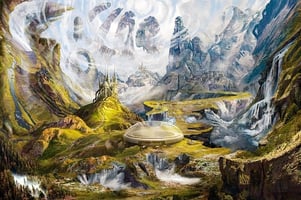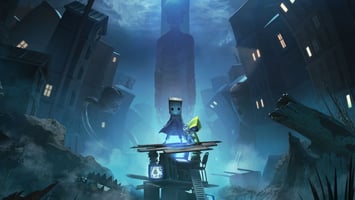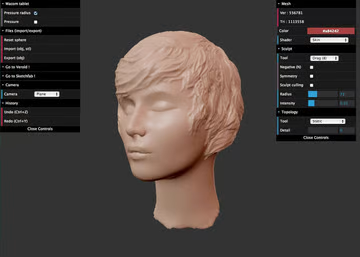Digital matte painting is an art form that has become increasingly popular in modern film...
What is an environment designer?
Environment Designer
As an Environment Designer, you can play a crucial role in bringing stories to life in the entertainment industry. An Environment Designer is responsible for creating both real-world and fantasy environments in films, television shows, video games, and other visual media.
You will become an expert in modelling, texturing, and lighting environments to create believable and immersive worlds. You will conceptualize, develop, and design these environments with the help of concept art, reference images, and other sources of inspiration.
From sketching and storyboarding to creating digital assets and 3D models, you’ll have the skills to create both realistic and abstract worlds. You will also have to work with the production team to understand their vision and bring it to life.
At MAAD, you can learn the essential skills to become an Environment Designer. Our experienced mentors will teach you the fundamentals of environment design, from concept to final render. You’ll learn industry-standard techniques for modelling, texturing, and lighting environments in Maya, 3D Studio Max, and other 3D software.
Whether you’re a beginner or a professional, you can benefit from our comprehensive online learning programs. With the help of our mentors, you can take your creative skills to the next level and become an in-demand Environment Designer.
What work does an environment designer perform?
An environment designer is responsible for creating the visual look and feel of a virtual or physical space. They work with a team to develop concept art, 3D models, and textures to create immersive and realistic environments. They are also tasked with ensuring that the environment meets the requirements of the project and communicates the intended narrative.
An Environment Designer is responsible for creating detailed environments for a variety of projects including video games, films, and television series. They create 3D models and textures, as well as develop elements such as lighting and colour to create believable, immersive worlds. They must have an eye for detail and a deep understanding of colour and composition in order to create a vibrant and believable environment.
Responsibilities of an environmental designer in film, TV, and video games
The role and responsibilities of an environmental designer in film, television, and video games are to create realistic settings for stories. An environmental designer in film, TV, and video games is responsible for creating the world that the characters inhabit. They design the environment, from the architecture and landscape to any props or furniture, to create an immersive and believable atmosphere for the characters and audience. This includes conceptualizing the environment, researching architectural styles and materials, creating sketches and illustrations, and building 3D models. They also work closely with the art director to ensure that the environment is consistent with the visual style of the production. Additionally, environmental designers often collaborate with the director and production designer to ensure that the environment is adequately represented on screen.
What skills are required to become an environment designer?
1. Knowledge of Environmental Design Principles
Environment designers must have an understanding of principles such as scale, proportion, texture, color, light, and sound.
2. 3D Modeling and Animation Skills
Environment designers must be able to create and manipulate 3D models in order to accurately depict the environment they are creating.
3. Creative Thinking
Environment designers must be able to think outside the box and come up with creative solutions to problems that arise during the design process.
4. Visualization Skills
Environment designers must be able to visualize the environment they are creating and be able to communicate this vision to others.
5. Understanding of Physics and Materials
Environment designers must have an understanding of physics and various materials and how they interact with each other to create an immersive environment.
6. Computer Programming and Scripting Skills
Environment designers must be able to create scripts and programs to control the environment and its elements.
7. Knowledge of Game Development and Game Design
Environment designers must understand how games are designed, developed, and played in order to create an environment that is both immersive and engaging.
What software and tools do environment designers use?
1. Autodesk 3ds Max: 3D modeling, animation, and rendering software.
Autodesk 3ds Max is a professional 3D modeling, animation, and rendering software designed for creating films, games, and 3D models. It is the most widely used software for 3D visualization and animation in the world. It is used in films, video games, architecture, and engineering. It is used by professionals in the entertainment industry, including game developers, visual effects artists, and animators. It offers a wide range of tools for creating characters, environments, and effects. It also provides powerful tools for simulating dynamics, such as particles and fluids. 3ds Max is known for its powerful animation capabilities, and its ability to generate realistic images quickly and efficiently.
2. Adobe Creative Suite: Photoshop, Illustrator, After Effects, Dreamweaver, and other creative tools.
Adobe Creative Suite is a collection of software programs from Adobe Systems that are used for graphic design, video editing, web development, photography, and other multimedia activities. The suite includes programs such as Photoshop, InDesign, Dreamweaver, After Effects, Illustrator, and Adobe Acrobat. Creative Suite programs allow users to create visually stunning projects, whether they are designing a website, creating a video, or editing a photo. Creative Suite is a powerful set of tools that can be used to create professional-looking projects quickly and easily.
3. Unreal Engine: Game engine used to build interactive 3D environments.
Unreal Engine is a game engine developed by Epic Games. It is a 3D game development engine used in the development of video games and other interactive applications. It features realistic environments, advanced graphics, and physics-based rendering. It can be used to create games for PC, console, mobile, and virtual reality platforms. Other features include a scripting language, networking, and an animation system. Unreal Engine has been used in a number of popular video games, including Fortnite, Gears of War, and Bioshock Infinite.
4. Unity: Cross-platform game engine used to create 3D environments.
Unity is a cross-platform game engine developed by Unity Technologies, first announced and released in June 2005 at Apple Inc.'s Worldwide Developers Conference as a Mac OS X-exclusive game engine. As of 2019, the engine had been extended to support more than 25 platforms. Unity is used to create half of the world's games. The engine can be used to create three-dimensional, two-dimensional, virtual reality, and augmented reality games, as well as simulations and other experiences. It is used to create applications for mobile devices, desktop platforms, consoles, websites, and virtual reality. Unity is a popular choice for game developers, since it supports both 2D and 3D graphics, as well as a wide range of development tools and languages. The engine also supports a variety of platforms, including iOS, Android, Windows, Playstation, Xbox, and more. Unity also offers a wealth of features, such as a physics engine, lightmapping, asset management, and more. The engine is also highly customizable, allowing developers to tailor their game to their exact needs.
5. Houdini: 3D animation and effects-creation software.
Houdini is a powerful 3D animation and special effects software used in the film and television industry. It is used to create realistic visual effects and dynamic 3D animations. It is a powerful tool for creating effects that would otherwise be impossible to achieve with traditional methods. Houdini can be used to create realistic simulations of fire, explosions, fluids, cloth, and other dynamic elements. It is used to create digital creatures and environments, and is popularly used for creating animated films and television shows.
6. ZBrush: Digital sculpting and painting program.
Pixologic’s ZBrush is a digital sculpting and painting program which is primarily used in the entertainment industry to create characters and creatures for movies, video games and other visual media. ZBrush combines traditional sculpting and painting with the power of a 3D modeling program. It is widely considered to be the industry standard for digital sculpting, and is used by professional artists in almost all major studios. ZBrush is a powerful and intuitive tool which allows artists to quickly and easily create detailed 3D models, textures and animations. It is also capable of creating stunningly realistic renders of materials, environments and characters. ZBrush is a great way to create stunningly detailed characters, creatures and environments for video games, movies and other visual media.
7. Maya: 3D animation and effects-creation software.
Maya is a 3D animation software used to create 3D models and animations. It is widely used in the film, television and video game industries. It is used to create 3D characters, objects, environments, and effects. Maya also has tools for creating realistic simulations of physical phenomena, such as fire, water, and cloth. It also has a particle system for creating complex effects such as smoke, fog, and explosions. Maya also has tools for rigging and animating characters and objects.
8. Substance Designer: Procedural texture-creation tool.
Substance Designer is a node-based material authoring tool designed to help 3D artists create complex materials for use in 3D projects. It is a powerful tool for creating textures and materials, with a wide range of tools available to create and manipulate textures. It is used in game development, film, and other 3D projects. Substance Designer is used by many major game developers and film studios and is the industry-standard texture creation tool.
9. Quixel Suite: 3D texturing software.
Quixel Suite 2 is a suite of digital painting and 3D sculpting tools developed by Quixel. It includes a variety of brush-based tools for painting textures, creating 3D objects, sculpting and retopologizing, and more. It also includes a library of over 1,500 high-quality textures and materials, as well as various other features. The suite can be used for creating game assets, film and VFX assets, concept art, and more.
10. World Machine: 3D terrain-generation software.
World Machine is a 3D terrain-generation software package that produces realistic, detailed terrain for use in 3D graphics and animation, game development, and architectural visualization. It uses proprietary algorithms to generate procedural, fractal-based, heightfields and seamlessly stitch them together to create large-scale environments. World Machine can generate terrains in a variety of resolutions, including low-resolution for quick previews and high-resolution for production-level environments. It can also generate textures, such as normal maps and color maps, to add realism to the generated environment.
How much does an environment designer earn?
Environment designers typically earn an average salary of $50,000 to $80,000 per year, depending on experience and location.




